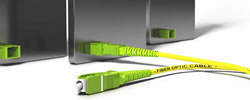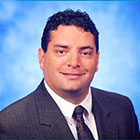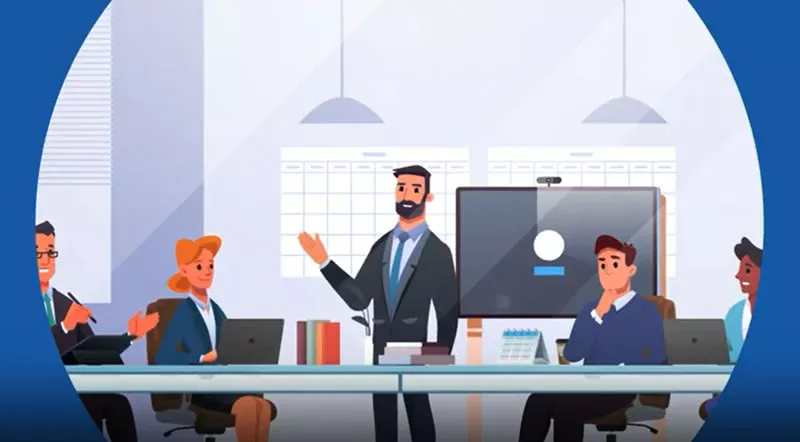Broadband Linkup
How to Detect Noise in Cable Communications
“SCTE is the best way to present our product, because they can really use it, play with it, move the source of noise and see how it changes.”

Foad Towfiq
CEO, Promptlink Communications
In today’s world of instant communication, it is crucial for businesses to have fast, effective lines of data transmission in order to keep pace with the global economy. In many cases, companies are using the pre-existing lines of cable laid for cable television to transmit data at high-bandwidth. But this application, known as DOCSIS (Data Over Cable Service Interface Specification), has a major issue—noise. Cable networks are vulnerable to noise and related issues that can cause big problems when it comes to quality of service.
On this episode of Broadband Linkup, a Promptlink Communications podcast, we discuss pin-pointing and troubleshooting the noise transmitted through cable modems with Foad Towfiq, President and CEO of Promptlink Communications.
“The detection of noise is very challenging," said Towfiq. “There’s not a single indicator imbedded in the cable modems or CMTS or other network elements that can show you where the noise is coming from. So this is the basic challenge that we have.”
But he divulged what tools he’s excited about that are helping remedy this common issue. These tools are helping probe, collect, and analyze data over time, assisting technicians in finding impairments before they develop into costly problems.
“How the noise is evolving, coming and going, is very important,” said Towfiq, explaining how algorithms and data are helping find problem areas before they progress.
“When you have a lot of data and analyzing this data, you can find pattern,” he said. Previously, without these tools, technicians would often need hours, even days, to troubleshoot and pin-point the source of noise in complex system.
Towfiq thinks companies will be “pleasantly surprised,” to discover a tool to assist in noise detection and localization and will be eager to try new methods to help keep business running smoothly.
00:00:02
Daniel Litwin: You’re listening to Broadband Linkup, your source for broadband industry info with Promptlink Communications.
00:00:22
Sean Heath: Welcome to broadband Linkup, a Promptlink Communications Podcast. I’m your host Sean Heath. Broadband is one of the greatest developments technologically, in my opinion, over the last, gosh, 30, 50 years. I mean, you’d have to go all the way back to, I don’t know, sliced bread. Is that too far? That may be going too far. I’ve gone too far. But that doesn’t mean it’s not a big deal. It is a very big deal, but it’s a lot more fragile than just regular everyday customers might realize. And I want to talk today to my guest about that fragility and how to strengthen it and a couple of tips and tricks that he has learned throughout his career on how to properly use broadband from every aspect. My guest on the podcast today is the CEO for Promptlink Communications, Foad Towfiq. Foad, how are you today?
00:01:15
Foad Towfiq: Thank you very much. I’m fine.
00:01:17
Sean Heath: So I do think sliced bread is very important, but broadband is right up there. I mean, it’s really close.
00:01:25
Foad Towfiq: You’re right. I agree with you.
00:01:27
Sean Heath: When we think about broadband, we think of it as being very stable, much more stable than say the old days of the TCP/IP the dial-up, and yet there are still some personality quirks that broadband has. It can be affected by line noise just as much as dial-up could have been.
00:01:49
Foad Towfiq: This is correct. Actually, the network, especially the cable network and the DOCSIS, has a lot of impairments and issues and that it gets all there. These impairments become more prominent and the effects on the quality of the service and the experience at the customer and the subscribers have will degrade little by little. So they need to monitor and maintain this network at all times.
00:02:19
Sean Heath: Monitoring, while it’s very important, that’s just the first step. That’s not enough just by itself, right?
00:02:25
Foad Towfiq: This is correct. Basically there are two areas in the network maintenance, one is the monitoring, detecting issues with the network, secondly diagnostics, finding the root cause of these issues. So this is more important because all day you can monitor and find issues about what to do about it. So you need to find the root cause and go and fix that.
00:02:48
Sean Heath: Well, let’s talk about that for a minute before we jump into the diagnostics. Let’s talk about monitoring because you’re constantly seeing the development of new tools and new methods for diagnostics that make it easier and more reliable to be able to find the root cause of network impairments. Can you talk to me about some tools that you are seeing come into the marketplace that are really helping you reach a greater level of success?
00:03:17
Foad Towfiq: You know, the DOCSIS specification started from DOCSIS 1.0 had included indicators that would be embedded in the cable modems, in other devices that can be pulled and get information and see the performance of that device. And this is all monitoring. Now the only thing that since the beginning of DOCSIS have been developed by the Cable Lab recently is proactive network monitoring. Basically what the cable modem can provide is some parameters that is called the pre-equalization parameters. And these parameters are used to correct for the effect of the impairments.
Now if you keep track of these corrections, you will be able to guess and even find approximately the location of these impairments that exists in to the network. So PNM or Proactive Network Monitoring is one of the new development that is being used and help the operators to find and do some diagnostics of the network.
00:04:39
Sean Heath: That’s pretty surprising. I would imagine that quite a few customers would be surprised to find out that upstream noise detection and localization are actually both possible because of tools that are currently on the market.
00:04:54
Foad Towfiq: Well, that is true because if the noise gets into the network and travel upstream, all the modems that are connected to that upstream are affected by this noise. And from the CMTS point of view, if you look into the network, you don’t see any difference between these modems. All of them look noisy. So finding the location of noise is very difficult and also very important because if you try to find basically the traditional method is to go from the fiber node, check every single element in the network downward and find the one that is close to the location that the noise is entering the network.
00:05:42
Sean Heath: Okay. So I want to clarify. If I have one node on the network, one modem that is the actual cause of the noise, it can pass that noise signature upstream to other modems on the network?
00:05:54
Foad Towfiq: That’s exactly right. The noise can come from one modem or it can come from one of the network elements such as an amplifier or a tap or maybe just a loose connector on the trunk cable. And this noise travels offward and all the modems that are communicating on that upstream seeing this noise and they are subject to this mess.
00:06:20
Sean Heath: That turns the search for the needle in the haystack into a search for a needle in a stack of needles. How can you possibly figure out which one is the one who started it all?
00:06:31
Foad Towfiq: Yeah. Basically over the years, we learned that if you collect enough data, some minute critical data can provide enough information where this noise location or noise [inaudible 00:06:50] location can be. Basically what we have developed at Promptlink is to analyze a large amount of data taken from the cable modems, from the CMTS, and sometimes from other network element and analyze them and come up with a probability where noise may be entering.
So we are looking at different location. When I say location, I mean the network elements or the cable modems themselves. And then by having this probability, we can have a map that shows the noise probably is entering at this point or in this area of the network. So it makes the life of the operator and the technicians much easier because if they would like to do in the traditional way, they have to move the ladder from one pole to another pole and open and close and go to another one and sometimes it takes several hours or several days to find the source of noise, especially if the source of noise are multiple, they’re not one location because sometimes one cable modem may be giving noises and another loose connector at the same time causing this noise. So this tool will help.
00:08:09
Sean Heath: The solution that you have come up with at Promptlink is called “Network NoiseHawk”.
00:08:16
Foad Towfiq: Yes.
00:08:16
Sean Heath: Talk to me a little bit about how proud you are of this product.
00:08:21
Foad Towfiq: I believe this is the only product of this nature in the markets right now and we are very proud and very happy because we are running some trials right now with some major customers and we are getting great results.
00:08:36
Sean Heath: It’s really able to hone in on the source of upstream noise, the localization, it’s able to find the source really reliably, but it also helps reduce the number of CPE field returns, and it’s pretty significant in how many returns it can help prevent.
00:08:54
Foad Towfiq: Right. CPE field returns is a little bit different than detecting noise. Let me explain. Again, when you are monitoring a network, you find areas that the elements of the cable modems and CPEs are not performing well. Now this lack of performance doesn’t mean that the CPE is not healthy or is defective. It only means it is not performing good. The lack of performance may be due to some other things, for example noise in the network or a bad unadjusted amplifier. So again, by collecting this large amount of data from different devices in the network, correlating them together and through the analysis, you can’t come up with a pretty good idea if the CPE is healthy but performing, bad, or it is not healthy and performing that.
So this will help the operator to make an informed decision about swapping the CPE. Currently, we have a statistic that over 80% of the CPEs taken from the networks are good CPEs. So you just imagine how much cost saving will this will provide for the operators.
00:10:22
Sean Heath: When we talk about data, we’re talking about massive amounts of data. And because DOCSIS networks are generally very large and I would imagine you have to address scalability constantly, is that like number one on your list of things to do every single day?
00:10:43
Foad Towfiq: That’s right. Actually, the scalability is a major issue because as you mentioned DOCSIS network is pretty large and the amount of data that we need to collect is also large. So just consider, a network with 500,000 modems, which is very common, one millisecond delay can translate into eight minutes, one millisecond, which is almost nothing.
Let me give you an example. You know, there is no symmetry of scale in the physical world. In the nature, there is no symmetry of scale. For example, if you have a dog, a greyhound, very agile and, you increase the size of this dog hundred times, in order for the dog to support its weight, it needs legs that are 10,000 times stronger. So a hundred times bigger dog, 10,000 times stronger. Therefore, your dog will not look like a dog anymore. It will look like a dinosaur most likely and this is what happens. I have seen many network monitoring in the DOCSIS world that they’re basically dinosaurs. They do things but not very efficiently or very effectively.
00:12:11
Sean Heath: One great thing about that example is in the network case, you can actually solve the issue.
00:12:20
Foad Towfiq: Yes.
00:12:20
Sean Heath: It is a situation that can be remedied. You just have to be smart in the way you go about it.
00:12:25
Foad Towfiq: That’s right. The smart [inaudible 00:12:26] is one thing and how to collect and how to save the data is another thing because collection of a lot of data is also very difficult on the spot. And also, when to you use your resources, that’s also very important. So not to put load on the network because a dinosaur can use everything that it eats just to sustain itself not to do anything else.
00:12:53
Sean Heath: Are there some technical trends that you see that are either already here or you see in the near future that give you optimism?
00:13:03
Foad Towfiq: Well, collecting large amount of data, doing the smart analysis using artificial intelligence, in some cases that gives us of course a lot of hope. In fact, two of the examples, one of them is this NoiseHawk, the product that we already have in the market, the second one, another product that will be introduced to the market very soon is preventing unnecessary swap of the healthy CPEs from the subscriber’s home. These are the two examples that I can give you.
00:13:38
Sean Heath: Are there any current challenges that you deal with consistently that will require a new approach to be able to overcome? I mean, do you have to change techniques in order to solve some of the challenges that you’re starting to see?
00:13:54
Foad Towfiq: Okay. The challenges, basically we know it is more or less clear the direction, which direction to go. The challenges are hard to make, create the right model and how to fine tune this in order to get the right results.
00:14:09
Sean Heath: And does that require a philosophical change or is it just a pragmatic organizational approach change that is necessary?
00:14:20
Foad Towfiq: No. No, not a physical change, a philosophical change is just using the right mathematics because when you have big data and a large of a large number of data, so we need to analyze them, what we analyze, which model to use, what result to get. If your model is not correct, the data that you fit to this model does not give you the right expectation, the result that you expect to see.
00:14:52
Sean Heath: We’ve touched on some pretty heavy topics today and is there a specific thing that you would like for people to take away from this podcast today that maybe we haven’t gone into detail about yet?
00:15:06
Foad Towfiq: Well the specific things I already mentioned about the scalability, which is very important. Secondly, collecting data and sometimes having some minute data, which are critical but minute, have good effect and have good importance, has a lot of importance basically.
00:15:26
Sean Heath: In your world, there is no such thing as a small detail.
00:15:32
Foad Towfiq: This is absolutely true. It is a little bit funny to say this, but sometimes we have noise that are stable and sometimes we have noisy noise. You see what I mean? This minute detail that differentiate between different kinds of noise by itself is the source of a lot of information that we can use for localization and the detection of it.
00:15:54
Sean Heath: Could it be compared to maybe a white noise generator that someone uses to help them fall asleep versus a leaf blower that somebody is using outside their window while they’re trying to go to sleep?
00:16:08
Foad Towfiq: Oh, the type of noise, yeah, you can compare them. Yes. That’s it.
00:16:12
Sean Heath: Well, today it has been my pleasure to have a conversation with the CEO for Promptlink Communications, Foad Towfiq. Foad, thank you so much for taking the time today and I would love to have another conversation with you anytime you have time in your schedule.
00:16:26
Foad Towfiq: Thank you very much and thanks for listening.

How Technology is Improving the Broadband User Experience
Chris Boring
VP, Sales and Marketing, Promptlink Communications

El mundo está más dependiente al wifi. ¿Lo podemos diagnosticar apropriadamente?
David Mosquera
Director, Latin American Sales, Promptlink Communications

More ISPs Are Offering ‘White Glove’ Wi-Fi Service for Better Consumer Experience
Chris Boring
VP, Sales and Marketing, Promptlink Communications

How to Detect Noise in Cable Communications
Foad Towfiq
CEO, Promptlink Communications

What to Watch for at SCTE Cable-Tec Expo
Chris Boring
VP, Sales and Marketing, Promptlink Communications

Cable-Tec Attendees Have Been ‘Out of Control Amazed’ with Network NoiseHawk
Foad Towfiq
CEO, Promptlink Communications

Multiple Content Streams, Single Content Pipe
Alexander "Shony" Podarevsky
Senior System Engineer, Promptlink Communications

Restauración de equipos es la estrategia rentable y ecológica para una industria de telecomunicaciones creciente
David Mosquera
Director, Latin American Sales, Promptlink Communications








